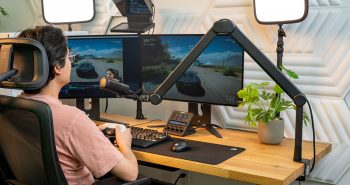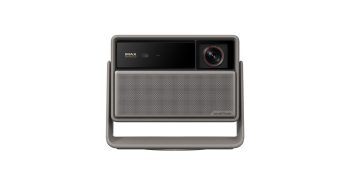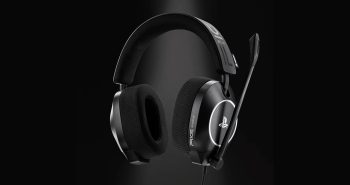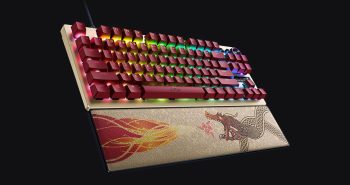The pinnacle of Microsoft’s Sidewinder gaming mouse line is their new X8. Their first wireless gaming mouse, the X8 brings some new features into the fray not previously seen on Sidewinder mice while also bringing back some features not seen on some newer ones.
The design of the Sidewinder X8 was definitely inspired by the original Sidewinder model. The new X8 is a bit smaller though and features slightly more ‘stealthy’ angles to it. Like the new X5, the X8 is of all-black coloring, although the X8 has actually two different sheens depending on the area. The main primary and secondary button fuselage is a shiny black while the separated grip areas are a flat. The scroll and Vista Games’ Panel buttons are silver, which really pop out in contrast. While plugged-in (we will get to this feature later) a red LED shines out of the back of the mouse. Overall, it is a very visually-pleasing design and is sure to attract attention at tournaments.
Tournaments, you say? Yes, I would happily take the X8 into a tournament any day of the week. The issues that plagues wireless mice, making them unsuitable for tourny use are all taken care of. A 2.4 GHz signal connects the mouse to its base unit, making interference very difficult, especially given how close you can sit the base unit to the mouse. Battery life is excellent with up to about a day of real usage per charge. The polling rate, while not as good as other gaming mice out there it seems fairly adequate for most DPI settings. I did find that when at the X8’s full 4,000 DPI setting it did tend to feel a bit jerky in some shooters. When scaling the sensitivity down to sub 3,000 it leveled out and became smooth and playable.
The X8 runs off of one rechargeable AAA battery, and can be replaced at any time with a fresh one should the need arise. However, you will not really need to given the awesome charging method Microsoft has designed the X8 to utilize. Charging the battery is done via a magnetic charging cable which connects to the front of the mouse. This magnetically-connected cable allows the mouse to still be playable while charging. Charging the battery back to full usually takes a couple hours or so, but being connected did not hurt my gaming performance at all.
One thing that was disappointing with the original Sidewinder was that the DPI-switching buttons were set so far back from the primary and secondary buttons you would have to actually move your whole hand back slightly to depress them. This could cost you your in-game life and made for a not so smooth gaming experience. In the X8, these buttons have been moved closer to the buttons which allows you to hit them without having to slide your hand back on the unit.
Microsoft has included a few different ‘feet’ designs inside the receiver dongle ‘box’ (it is actually a cylinder) allowing you to customize the level of traction your X8 gets on your prefered gaming surface. The receiver dongle is a a black, cylindrical box which contants the multiple feet as well as a track around the perimeter with which to wrap the magnetic charging cable. The unit is simply with a classy aesthetic that complements the X8 quite well.
Speaking of surfaces, thanks to Microsoft’s BlueTrack laser technology, the X8 is able to be used on a ton more surface-types than before. We were even able to get the mouse functioning, although admittedly-sloppily on the side of a ceramic, shiny mug.
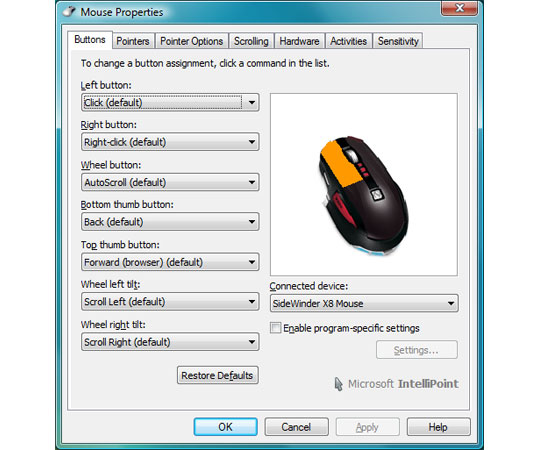
The software needed to use the X8 was a breeze to install and integrates itself with the standard Windows Vista mouse properties screen where you can assign every one of the X8’s seven programmable buttons to whatever you like. Another addition to the X8’s programmability is its macro record button which allows you to set a macro while in-game on-the-fly.
The new scroll wheel, which hearkens back to the original SideWinder, is all metal and an attractive silver. The down-side is that we found the scroll wheel to be very difficult to roll. It feels clunky with very pronounced detentes and poor friction. A rubberized wheel might have been a better way to go, but would have clashed with the color scheme they were going for. A plus to this scroll wheel is that it now has tilt-clicking, something which no other SideWinder mouse has featured until now.
Microsoft has chosen to replace the original SideWinder’s two fore-mounted side buttons with ones actually located on the side of the mouse this time. This side-mounted design makes it very easy for your thumb to use, especially with their vertically-mounted layout. Tilt your thumb up slightly and tag the upper side button, tilt it down and, well, you get the idea. 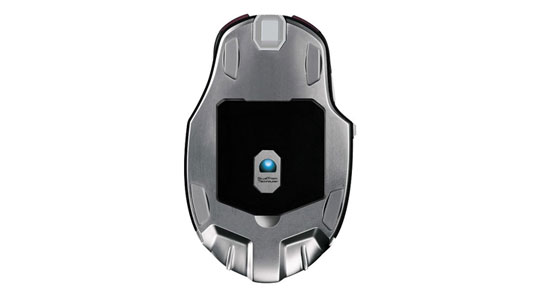
SideWinder X8 also shows the return of the left-mounted LCD display on the thumb area which was not present in their more bare-bones SideWinder X5. This time, it shows not only what DPI mode the mouse is in but also the battery charge level.
Overall, we found the SideWinder X8 to be a very good gaming mouse made even better by its wireless capability. We would not have any problem taking the unit into a tournament situation or even using it for simple desktop applications. While it does have its flaws, the X8 is the best wireless gaming mouse on the market at the time of this writing, although at an original MSRP of $99.99 it could be a strain for those on a budget.

